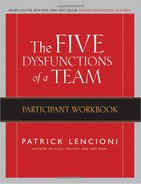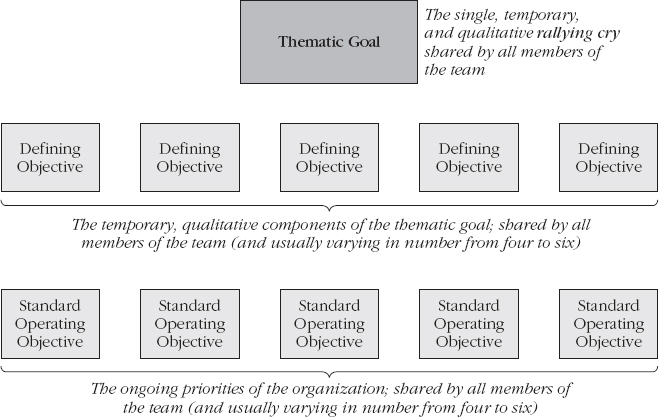FUNDAMENTAL #3: Achieving Commitment
Teams that commit to decisions and standards do so because they know how to embrace two separate but related concepts: buy-in and clarity. Buy-in is the achievement of honest emotional support. Clarity is the removal of assumptions and ambiguity from a situation.
COMMITMENT ASSESSMENT ITEMS
- 11. Team members leave meetings confident that everyone is committed to the decisions that were agreed upon.
- 19. Team members end discussions with clear and specific resolutions and calls to action.
- 24. The team is clear about its direction and priorities.
- 28. The team is aligned around common objectives.
- 30. The team is decisive, even when perfect information is not available.
- 34. The team sticks to decisions.
- 38. Team members support group decisions even if they initially disagreed.
NOTES

COMMITMENT CLARIFICATION
- Five minutes before the end of every meeting, the team leader asks, “What exactly have we decided here today?” Then the leader writes on a white board or flip chart page every decision the group thinks it has made.
- The team members review each decision to make sure that it's what they thought they had agreed on. If not, the group dives back into the conversation until everyone is clear.
- When everyone agrees that the decisions are clear, everyone writes them down.
- The team then decides which of the commitments and agreements should be communicated to the rest of the organization.
NOTES

CASCADING COMMUNICATION
- Within 24–48 hours of any meeting, every member of the team communicates the decisions the team made to their staff members and any teams they lead.
- Communicate these decisions in person, or on the phone, not by e-mail, so people have a chance to ask questions for clarification.
NOTES

THEMATIC GOAL MODEL
ESTABLISHING A THEMATIC GOAL
A Thematic Goal is a single overriding theme that remains the top priority of the entire team for a given period of time.
Elements of a Thematic Goal:
- Single
- Qualitative
- Time-bound
- Shared
NOTES

OUR TEAM'S THEMATIC GOAL
Write down your answer to this question:
What do you think is the single most important goal to achieve during the next ______________ months if our team is to consider itself successful?

OUR THEMATIC GOAL DETAILS
Fill in the following lines with your team's Thematic Goal, Defining Objectives, and Standard Operating Objectives.
Thematic Goal

Defining Objectives

Standard Operating Objectives

RULES OF ENGAGEMENT
Use the space below to write the principles that your team agreed to.
- The structure and schedule for meetings:

- Acceptable behavior during meetings:

- The preferred methods for communicating with one another and the norms around how to use each method:

- The timeliness of responding to one another:

- The use of shared resources:

- The extent to which we will be available during non-work hours for meetings or to answer questions:

- The level of freedom we have when interacting with one another's staff:

- The extent to which being on time to meetings is a priority:

KEY POINTS—ACHIEVING COMMITMENT
- Commitment requires clarity and buy-in.
- Clarity requires that teams avoid assumptions and ambiguity, and that they end discussions with a clear understanding about what they've decided upon.
- Buy-in does not require consensus. Members of great teams learn to disagree with one another and still commit to a decision.
NOTES ON ACHIEVING COMMITMENT

Commitment is about a group of intelligent, driven individuals buying in to a decision precisely when they don't naturally agree. In other words, it's the ability to defy a lack of consensus.
Great teams embrace disagreement and actually enjoy moments of temporary indecision. They take pleasure in making, rallying around, and buying in to decisions when the “right” answer seems nowhere to be found.
Most people don't really need to have their ideas adopted (a.k.a. “get their way”) in order to buy in to a decision. They just want to have their ideas heard, understood, considered, and explained within the context of the ultimate decision.

